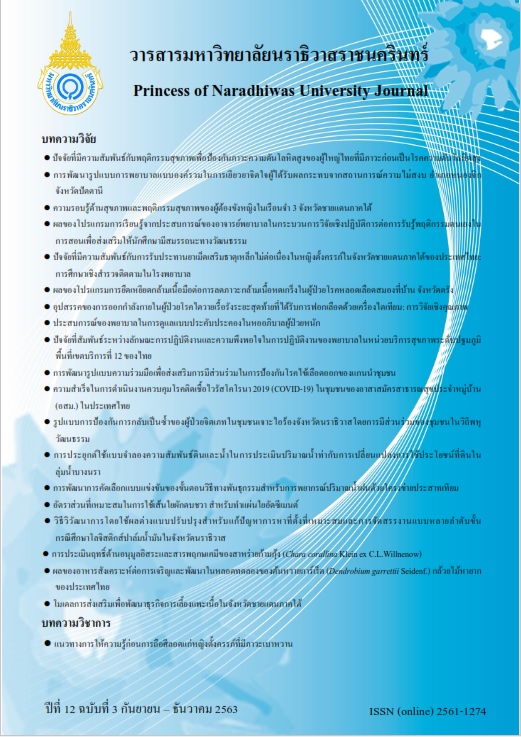การพัฒนาการคัดเลือกแบบแข่งขันของขั้นตอนวิธีทางพันธุกรรมสำหรับการพยากรณ์ปริมาณน้ำฝนด้วยโครงข่ายประสาทเทียม
คำสำคัญ:
การคัดเลือกแบบแข่งขัน, วิธีทางพันธุกรรม, โครงข่ายประสาทเทียม, การพยากรณ์ปริมาณน้ำฝนบทคัดย่อ
การวิจัยนี้มีวัตถุประสงค์เพื่อพัฒนาการคัดเลือกแบบแข่งขันของขั้นตอนวิธีทางพันธุกรรมสำหรับการพยากรณ์ปริมาณน้ำฝนด้วยโครงข่ายประสาทเทียม (ANN) โดยอาศัย 30 หลักการ ได้แก่ 1) หลักการจัดลำดับที่พันธุกรรมให้เป็นค่ามาตรฐาน (NGR) 2) หลักการคัดเลือกแบบวงล้อรูเล็ต (RWS) และ 3) หลักการคัดเลือกแบบแข่งขัน (TS) การวิจัยแบ่งออกเป็น 2 ส่วน ได้แก่ ส่วนแรกเป็นการพัฒนาตัวแบบพยากรณ์ภายใต้การจำลองข้อมูล 1100 ข้อมูล ทำซ้ำ 1000 รอบ และส่วนที่สองเป็นการนำตัวแบบพยากรณ์ที่ได้จากส่วนแรกมาใช้พยากรณ์ ในส่วนนี้จะนำข้อมูลจริงมาใช้โดยทำการแบ่งข้อมูลออกเป็น 2 ชุด คือ ชุดการเรียนรู้ และชุดการทดสอบ คิดเป็นร้อยละ 77 และ 23 ตามลำดับ จากนั้นทำการเปรียบเทียบประสิทธิภาพการพยากรณ์ระหว่างตัวแบบโครงข่ายประสาทเทียมที่พัฒนาการคัดเลือกแบบแข่งขันกับตัวแบบโครงข่ายประสาทเทียมที่ใช้การคัดเลือกแบบเดิมของ Wang et al. (2017) โดยพิจารณาประสิทธิภาพการพยากรณ์จากค่าคลาดเคลื่อนสัมบูรณ์เฉลี่ย (MAE) ค่าคลาดเคลื่อนร้อยละสัมบูรณ์เฉลี่ย (MAPE) รากของค่าคลาดเคลื่อนกำลังสองเฉลี่ย (RMSE) และค่าสัมประสิทธิ์ตัวกำหนด (R2) ตัวแปรนำเข้าในโครงข่ายประสาทเทียมได้แก่ ความชื้นสัมพัทธ์ของอากาศ ความเร็วลมและทิศทางลมในแนวตะวันออก–ตะวันตก ความเร็วลมและทิศทางลมในแนวเหนือ–ใต้ การระเหยของน้ำ อุณหภูมิอากาศสูงสุด อุณหภูมิอากาศต่ำสุด และอุณหภูมิอากาศเฉลี่ย และตัวแปรออกได้แก่ ปริมาณน้ำฝนของภาคกลางในประเทศไทย ข้อมูลที่ใช้นำมาวิเคราะห์เป็นข้อมูลรายฤดูกาลจำนวน 1100 ข้อมูล ผลการวิจัยแสดงให้เห็นว่าตัวแบบพยากรณ์ที่พัฒนาการคัดเลือกแบบแข่งขันมีประสิทธิภาพการพยากรณ์มากกว่าตัวแบบพยากรณ์ที่ใช้การคัดเลือกแบบเดิมของ Wang et al. (2017) ในทุกฤดู
เอกสารอ้างอิง
Asadi, S., Shahrabi, J., Abbaszadeh, P., & Tabanmehr, S. (2013). A new hybrid artificial neural networks for rainfall–runoff process modeling. Neurocomputing, 121(1), 470-480.
Goldberg, D. E. (1989). Genetic Algorithms in Search, Optimization and Machine Learning. Massachusetts: Addison–Wesley Longman, Inc.
Goldberg, D. E., & Deb, K. (1991). A comparative analysis of selection schemes used in genetic algorithms. In Foundations of genetic algorithms. Elsevier, 1(1), 69-93.
Golic, K. (2013). Application of a Neural Network Model for Solving Prediction Problems in Business Management. Journal of Economics, Business and Management, 1(1), 146-149.
Gupta, D., Vasudev, K., & Bhattacharyya, S. (2018). Genetic algorithm optimization based nonlinear ship maneuvering control. Applied Ocean Research, 74(1), 142-153.
Houck, C. R., Joines, J., & Kay, M. G. (1995). A genetic algorithm for function optimization: a Matlab implementation. Ncsu-ie tr, 95(9), 1-10.
Joines, J. A., & Houck, C. R. (1994). On the use of non-stationary penalty functions to solve nonlinear constrained optimization problems with GA's. In Proceedings of the First IEEE Conference on Evolutionary Computation. IEEE World Congress on Computational Intelligence: 579-584. Orlando: IEEE.
Kantanantha, N. (2012). Forecasting by Causal Methods. Engineering Journal, 4(1), 33-48.
Khadwilard, A. (2011). Application of Genetic Algorithm for Optimisation Problems. RMUTP Research Journal, 5(2), 153-163.
Meesad, P. (2012). Fuzzy Systems and Neural Network. Bangkok: Faculty of Information Technology KMUTNB.
Mekparyup, J., & Saithanu, K. (2011). Performance of Neural Networks, Multi-Layer Perceptron and Radial Basis Function, for Multivariate Quality Control Charts. Burapha Science Journal, 16(2), 97-106.
Mislan, Haviluddin, Hardwinarto, S., Sumaryono, & Aipassa, M. (2015). Rainfall Monthly Prediction Based on Artificial Neural Network: A Case Study in Tenggarong Station, East Kalimantan-Indonesia. Procedia Computer Science, 59(1), 142-151.
Mohammadi, M., Lakestani, M., & Mohamed, M. (2018). Intelligent parameter optimization of Savonius rotor using Artificial Neural Network and Genetic Algorithm. Energy, 143(1), 56-68.
NOAA NCEP-NCAR. (2019). International Research Institute for Climate and Society. [Data file]. Available from International Research Institute for Climate and Society Web site, http://iridl.ldeo.columbia.edu/SOURCES/.NOAA/.NCEP-NCAR/
Nontasud, K., & Wessapan, T. (2017). A Prediction Model of Electricity Consumption as Applied to Development Planning of Chiang Mai International Airport. EAU Heritage Journal Science and Technology, 11(3), 124-136.
Oladele, R., & Sadiku, J. (2013). Genetic algorithm performance with different selection methods in solving multi-objective network design problem. International Journal of Computer Applications, 70(12), 5-9.
Phatcharopaswatnagul, A., Satienpirakul, K., Sittbisuntikul, K., & Sinnarong, N. (2017). Impact of climate change to cassava production in The northeast region. Veridian E-Journal, Silpakorn University, 10(3), 2528-2540.
Phiwma, N. (2015). Developing A Model for Forecasting Trends of Matching between A Job Applications and A Computer Degree Using Artificial Neural Network. Panyapiwat Journal, 7(2), 1-16.
Prakobphol, T. (2009). Artificial Neural Networks. HCU Journal, 12(24), 73-87.
Raeisi-Vanani, H., Shayannejad, M., Soltani–Toudeshki, A.–R., Arab, M.–A., Eslamian, S., Amoushahi–Khouzani, M., Marani–Barzani, M., & Ostad–Ali–Askari, K. (2017). A Simple Method for Land Grading Computations and its Comparison with Genetic Algorithm (GA) Method. International Journal of Research Studies in Agricultural Sciences (IJRSAS), 3(8), 26-38.
Saengsawang, S. (2016). Appling of Artificial Neural Network in The Agriculture. The Journal of KMUTNB, 26(2), 319-331.
Saxena, A., Verma, N., & Tripathi, K. (2014). Neuro-genetic hybrid approach for rainfall forecasting. Int J Comput Sci Inf Technol, 5(2), 1291-1295.
Shaikh, L., & Sawlani, K. (2017). A rainfall prediction model using artificial neural network. International Journal of Technical Research and Applications, 5(2), 45-48.
Sihananto, A. N., & Mahmudy, W. F. (2017). Rainfall Forecasting Using Backpropagation Neural Network. Journal of Information Technology and Computer Science, 2(2), 66-76.
Wang, Z.-H., Gong, D.-Y., Li, X., Li, G.-T., & Zhang, D.-H. (2017). Prediction of bending force in the hot strip rolling process using artificial neural network and genetic algorithm (ANN-GA). The International Journal of Advanced Manufacturing Technology, 93(9-12), 3325-3338.
Whitley, D. (1994). A Genetic Algorithm Tutorial. Statistics and Computing, 4(2), 65–85.
Yu, F., Fu, X., Li, H., & Dong, G. (2016). Improved Roulette Wheel Selection-Based Genetic Algorithm for TSP. Paper presented at the Network and Information Systems for Computers (ICNISC). 2016 International Conference on Network and Information Systems for Computers: 136-140. Shenzhen: Atlantis Press.




